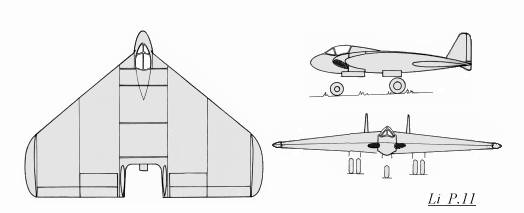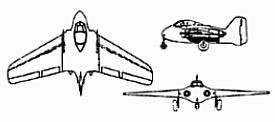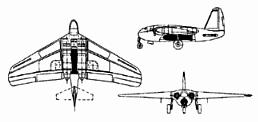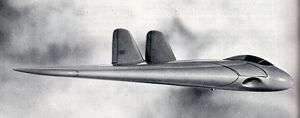 In the late summer of 1942, Alexander Lippisch was working on the P.11
twin-jet fast bomber. When the Horten Ho IX was chosen instead, work was
stopped on the P.11. One year later, the RLM then issued an official contract
to develop a "Very Fast Bomber" that was based on Lippisch's earlier research.
The project was renamed "Delta VI" upon completion of design work on an
unpowered glider, which was to serve as the initial prototype. The RLM
bestowed the highest priority on producing a fighter version. The LFA (Aviation
Research Institute) constructed models, mock-ups and carried out windtunnel
research and made ready for production. By Febuary 1944, design work for
the proposed fighter, fighter-bomber and heavy fighter was nearly complete.
The wing was swept back at 37 degrees, and the low wing loading promised
a good climb capability and excellent maneuverability. Armament was to
be two MK 103 30mm cannon mounted in the wings, with a provision for an
additional two MK 103 30mm cannon or one BK 7.5 75mm cannon in an external
pack. Dr. Lippisch hoped to commence flight tests with the unpowered glider
by April 1944, with the two Jumo 004B turbojet powered version to be flying
by July 1944. The center section of the of the unpowered glider Delta VI
was captured by American troops at Salzburg, this being the only part of
the aircraft to be completed.
In the late summer of 1942, Alexander Lippisch was working on the P.11
twin-jet fast bomber. When the Horten Ho IX was chosen instead, work was
stopped on the P.11. One year later, the RLM then issued an official contract
to develop a "Very Fast Bomber" that was based on Lippisch's earlier research.
The project was renamed "Delta VI" upon completion of design work on an
unpowered glider, which was to serve as the initial prototype. The RLM
bestowed the highest priority on producing a fighter version. The LFA (Aviation
Research Institute) constructed models, mock-ups and carried out windtunnel
research and made ready for production. By Febuary 1944, design work for
the proposed fighter, fighter-bomber and heavy fighter was nearly complete.
The wing was swept back at 37 degrees, and the low wing loading promised
a good climb capability and excellent maneuverability. Armament was to
be two MK 103 30mm cannon mounted in the wings, with a provision for an
additional two MK 103 30mm cannon or one BK 7.5 75mm cannon in an external
pack. Dr. Lippisch hoped to commence flight tests with the unpowered glider
by April 1944, with the two Jumo 004B turbojet powered version to be flying
by July 1944. The center section of the of the unpowered glider Delta VI
was captured by American troops at Salzburg, this being the only part of
the aircraft to be completed.
![]() View Tor Pedersen's Lippisch Li P.11 LuftArt images
View Tor Pedersen's Lippisch Li P.11 LuftArt images
Span: 10.8m (35' 5.5") Length: 7.49m (24' 7.1") Max. Speed: 1040 km/hr (646 mph)


